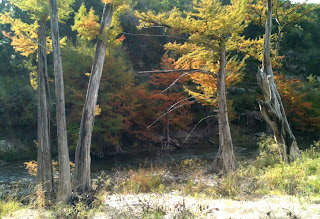How does a photographer know and select when the right image has been achieved? Three basic methods (and their respective hardware systems) have been developed over the past couple of centuries: the groundglass, the optical viewfinder, and P&S (point and shoot). Although this list is more or less an historical sequence it does not quite reflect a linear evolution as it has ebbed and flowed and produced hybrid results along the way.
 |
| Rudimentary groundglass setup, using a magnifying glass as the imaging lens, and white plastic film as the groundglass, © Bill Brockmeier, 2012 |
Fundamentally, the operator was looking directly at what the final photograph would look like, identical in size as well as composition, albeit upside-down due to the geometric realities of lenses. When in place, the groundglass became the surrogate for the photographic plate. Once the proper focus and desired composition was set the groundglass could be removed and the actual photographic plate inserted in its place. Finally, the image would be exposed onto the photographic plate and recorded for posterity. With the camera work complete all that remained was to chemically reveal (develop and stabilize) the image on the plate.
 |
| HIS OWN WORLD, © Bill Brockmeier, 2012 all rights reserved. |
Hidden beneath his black cloth and behind his camera, the artist is optically isolated from the real scene and is alone with his illuminated image on the groundglass. Of the three basic composition systems I mentioned above this method probably most removes the artist from the external reality which is the source of his image. This situation, coupled with the fact that the image is being viewed upside-down, provides a certain level of abstraction of the image. Only by frequent immersion in this inverted image-world and by a dogged determination to see the real world-as-it-is beyond this inversion can the abstraction be avoided.
The image on the groundglass is actually evidence not of the scene (the objective reality) but rather of the photograph– the image, the art, even the mind of the artist (the subjective reality). This groundglass method of composing the image, as archaic and outmoded as it seems today, has achieved a high renaissance in recent years. Although most don't realize it, modern computerized digital cameras possess their own high-technology version of the groundglass– the electronic display.
 |
| The electronic display– a modern version of the groundglass plate, © Bill Brockmeier, 2012 |
Also, because the photographer is looking at an image that is within arm's reach (for both the groundglass and the electronic display) he is further separated from the external world. The fact that this image is physically close to the photographer causes his eyes to accommodate, or focus closer, on this nearby object. That may not seem like much of a consideration, but the brain interprets what it sees substantially based on this level of accommodation. Certain powerful optical illusions (like the "moon illusion") depend heavily upon the degree to which the eye's lens is focused. Looking at an absolutely identical image at close range is perceptually very different than seeing the original scene at a distance. This effect can further abstract the image for the photographer.
These abstracting aspects of the electronic display– the new "groundglass"– have revolutionized my own approach to this art. Once I became connected to the immediate ability to hold in my own hands a replica of the final photograph– before it had even been taken– I couldn't imagine ever going back to the "dark ages" of shoot-and-hope.




